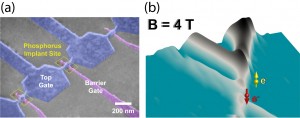Single Atom Transistor?

Researchers from Helsinki University of Technology (Finland), University of New South Wales (Australia), and University of Melbourne (Australia) have succeeded in building a working transistor, whose active region composes only of a single phosphorus atom in silicon. The results have just been published in Nano Letters.
Source: Single-atom transistor discovered
The working principles of the device are based on sequential tunneling of single electrons between the phosphorus atom and the source and drain leads of the transistor. The tunneling can be suppressed or allowed by controlling the voltage on a nearby metal electrode with a width of a few tens of nanometers.
The rapid development of computers, which created the present information society, has been mainly based on the reduction of the size of transistors. We have known for a long time that this development has to slow down critically during the future decades when the even tighter inexpensive packing of transistors would require them to shrink down to the atomic length scales. In the recently developed transistor, all the electric current passes through the same single atom. This allows us to study the effects arising in the extreme limit of the transistor size.
“About half a year ago, I and one of the leaders of this research, Prof. Andrew Dzurak, were asked when we expect a single-atom transistor to be fabricated. We looked at each other, smiled, and said that we have already done thatâ€, tells Dr. Mikko Möttönen. “In fact, our purpose was not to build the tiniest transistor for a classical computer, but a quantum bit which would be the heart of a quantum computer that is being developed worldwideâ€, he continues.
Problems arising when the size of a transistor is shrunk towards the ultimate limit are due to the emergence of so-called quantum mechanical effects. On one hand, these phenomena are expected to challenge the usual transistor operation. On the other hand, they allow classically irrational behavior which can, in principle, be harnessed for conceptually more efficient computing, quantum computing. The driving force behind the measurements reported now is the idea to utilize the spin degree of freedom of an electron of the phosphorus donor as a quantum bit, a qubit. The researchers were able to observe in their experiments spin up and down states for a single phosphorus donor for the first time. This is a crucial step towards the control of these states, that is, the realization of a qubit.

Leave a Reply
Want to join the discussion?Feel free to contribute!